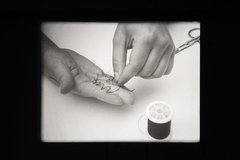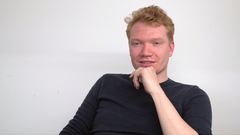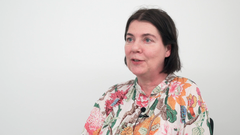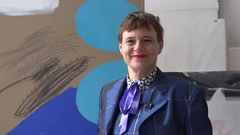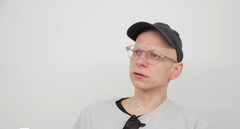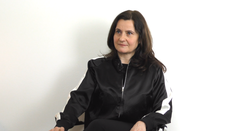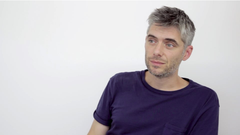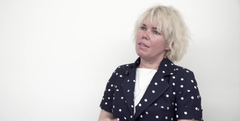Open, ambivalent, and coded on multiple levels—Ute Müller’s sculptures, installations, and paintings are anything but easy to grasp. A conversation about the value of abstraction, the role of transformation and change, and a lack of words for one’s own artistic production.
To me, it’s not enough if something functions on one level only
Dominikus Müller: Ute, at first glance you seem to work rather sculpturally, at second glance in a very installative way. How do the arrangement and the individual object interrelate for you?
Ute Müller: I deal with things as a whole, like an alphabet, or like a trove, a set of props. And of course their function is different depending on the position in relation to the other elements. But instead of having one meaning only, even the individual things themselves have several facets that can be interrelated. In my exhibition at the Künstlerhaus, for example, I am showing a metallic object that is actually very volcanic and looks rough somehow, but on the other hand it has—when viewed from a different side—a clean, sharply delineated raw edge, copper-colored and oval. This yields a clear basic form that is easily associated with other geometric forms, while displaying a powerful contrast to the rest of the object. By the way, this is a fragment of a casting channel or sprue, which was severed at this spot.
So would you say that you are concerned in your work with a vocabulary that is composed of references, differences, repetitions and that works on various levels: as “pure form,” as material, as function, and sometimes even as symbolic meaning?
It seems to me that the things I use communicate an absurdity of sorts. They can engage with one another in very different ways. For example, I implement molds made of latex again and again since I appreciate the material’s capacity to remember, it’s a kind of memory medium. Sometimes these things engage on a purely formal level, while other times several possible conversations are overlaid—about color, about form, and occasionally even through references to something totally different, such as the previous example regarding the remnants of a casting process. This case generally refers to a production process, and more specifically to art production. As to which sculpture was actually cast through this channel, I don’t know. I never saw it.
Of course it impacts the perception of this object if it’s clear that we’re dealing with a remnant of artistic production, which itself is once again being elevated to the status of an artwork here. Is such cross-fading of different levels—the act of emphasizing or, elsewhere, the concealing of references—important for your work?
Yes. But here the spatial component is especially crucial, the question where and how something is positioned in space. And then also how this relates to the factor of time. Because different states of one and the same thing can be correlated—such as this very casting channel where, depending on the vantage point, different aspects are pushed to the fore, such as the volcanic-organic facet or the smooth-geometric one.
How might we imagine working with the factor of time in sculpture and also in painting?
In the case of sculpture it is easier to address this level, because the perception of sculpture is always already dynamic. It is organized through movement in space and thus automatically includes consecutive shifts in perspective. As a viewer of sculpture, one operates in a clear temporal sense than in the case of a painting. A painting is usually on a single plane, making our standpoint a frontal one. This is actually one of the main topics, especially in relation to my paintings: How can one address the time-space issue within the parameters of painting? How could an analogous dynamic perception function within painting?
So how do you address this?
For one, I have let go of any recognizable motif. When an object is represented that is not situated in the same space, but rather in the space of the image, this object remains cut off, is fixated by language, caught in a conceptual space and thus only experienceable in the mind. Yet moving into the abstract signifies a departure from this space. The abstract can be experienced in a much more dynamic way. But this alone is not enough for me. So from this purposefully ambivalent point of access I develop additional structures, and although the forms were originally recognizable, the idea here is not focused on individual concepts, but on their interrelation. In general, the following applies: painting is an area that I prefer to leave blank, at least as blank as possible. I would like to avoid certain terminology and certain associations.
Do you mean a certain ever-determining way of designating what you are dealing with?
Thinking in terms of associations functions differently in painting. Sculpture and installation are much opener in this respect; one thing leads to the next, and there is always an immediate reference to the body. The matter plays out faster if categorization is avoided. While this may be possible in the case of painting, it is also considerably more complicated, with things much more quickly sorted into a “yes” and a “no.” Painting is more hermetic as a system on the whole.
Do you mean in the sense that a canvas is a much more strongly closed system of coordinates, that it is much more rigidly organized and in fact not as multilayered as an accessible space?
Precisely. Although I do use quite a few methods to bypass this, for example hanging the paintings low. Because the higher they are hung, the further away it goes from the body into the space of thought. I build my paintings in many layers that are more or less translucent, allowing for the different layers to begin to communicate with each other. It is for this reason that I also use egg tempera, because it allows light to shimmer through all layers in a certain way and pierce through them. This layering is a link to my sculptures: just as we can move through a space, it’s also possible to move through the layers of a painting. This gives rise to a temporal dimension. But once again: finding a language for painting doesn’t make sense to me. I think it’s important that painting opens up its own unique space that initially robs one of language. Even I have an easier time talking about the sculptures. When dealing with painting, there is often an urge toward definition wherein lies the danger of becoming too concrete. In comparison, there is the cast object, where I only use what has been left over. The actual cast is no longer visible. For me, painting navigates this realm of what is no longer there.
Then let us go back to the sculptures. Earlier, you mentioned latex molds, and they are also shown in the Graz exhibition.
From the very outset, simple, space encompassing, geometric forms or principles were important for the exhibition: square, circle, line, and so forth. Additionally, I use found things that I sometimes copy in order to reuse them in multiple installations. For example, I created a latex mold of a stone and then poured plaster into this negative. So there is the stone, its negative in latex, but also a kind of open plaster copy of the stone, in the form of an absurd vase, which possesses an entirely new material quality.
So while it is one mold, it is literally an open one?
Exactly. I am never concerned with some kind of original. This does not interest me in either in painting or in my work with objects. My pictures are actually never painted to the end. At some point they reach a certain density and saturation, the moment or state in which something happens. Then I can show them. But eventually I would revise every painting.
When, for you, are the works then finished? Or to phrase it more accurately: When do you show them?
As compared to music, one might say: when a certain rhythm sets in. Another word for this would basically be saturation, meaning that something has enough levels to trigger the most diverse references or to engage with many other things. For me, it’s not enough if something functions on one level only. And again, this is a significant problem in painting: applying just one layer of paint may be incredibly intuitive, but after that it really becomes difficult. Only after two or more levels does the issue of relations arise.
This issue is also found, in a slightly different way, in your sculptural arrangements. The relationship mutually emerging among the individual elements is usually at least just as important as each individual object.
It’s important for me that something happens to these things. Almost like in a film. The arrangements specify a plot of sorts. One doesn’t know what happened before or what will happen later but one can see that something is or will happen to these things.
What importance do concepts like stringency and logic hold in your work?
It’s not important to me that things are grasped as a whole. In fact, I constantly resist the idea of defining things. I want them to be open so that as much as possible can occur. I am always very fascinated by artists who can speak about their work with great determinacy and thus convey a kind of stringency and logic in that they can specify where each form comes from and how it all interrelates. I find this fabulous, but for my work it’s not the right path.
I have also noticed how incredibly difficult it is, when considering your work, to precisely determine what we are really dealing with. But I like this, because here something is evading the narrative place.
It took quite a long time to become accustomed to the fact that it functions just this way. I may be working with these things, but I can only conditionally convey them in this sense. There is definitely a kind of voicelessness toward one’s own production and creativity. It’s almost like a black hole. But even such inability can be form-generating in the end.
How so?
Sometimes what I intend to do just doesn’t work out, but through this act of failure another new form emerges. So I think that what I do can best be described as “scenic”: the idea is to create conditions within which something can change and meaning can shift. Ultimately, it is about movements. And when it comes to such openness, it is really vital that things are ambivalent.
Many of your objects also have something very tactual, kind of a special surface that one wants to touch—at least I do! What role does tactility play for you?
There are for instance tubular sculptures where I pressed clay into the inside of a tube with my hands. The unfired clay is velvety, and at the same time these chimney forms with the fingerprints inside seem absurd. But it is true: in general a great deal happens through the material. It is on a par with the other areas. However, my decision to use a certain material is never decided in advance; it first evolves during the process.
What significance do concepts like translation and copy have for you?
To me, copying is a form of translation. And translation means: bringing something from one space into another. This involves transfers where incredibly much can happen. Important here is not what a thing was, or what it will become, but what happens to it during the moment of transformation. One might say, if you will, that I am always exploring the possibility of veritably “pulling out” one form from another, such as creating a tube from a circle. This is basically comparable to the approach taken by a 3D program where simple forms are generated through extrusion from a surface or collapse in the opposite direction.
Maybe it has to do with these intermediate states that—it seems to me—many of your things play out along the margins of formlessness, or, to phrase it differently, that their form is precarious, temporary, half-finished, caught somewhere between A and B.
In a certain sense, all of this is something abstract. And abstract things are elusive, at times lacking any real language, or they can be more than one, can elude appropriation and understanding in full.
In this respect, we are dealing here not with simple objects, but in actuality with “things” in a strong sense—a thing that is simultaneously more and less than an object, a thing that is a strange intermediate space, too close yet also far away.
Exactly, it definitely has to do with such intermediate steps and stages, with a fluctuation, and with the fact that we don’t really know what we’re dealing with. And maybe this is actually the point that we had discussed at the beginning: that one thing can potentially be many.
Ute Müller, exhibition view, 2017
Künstlerhaus, Halle für Kunst & Medien, Graz, photo: Ute Müller

